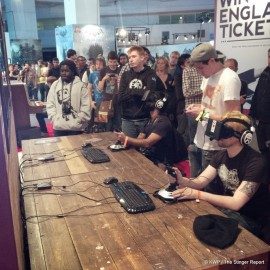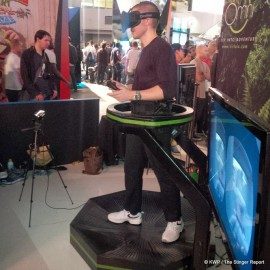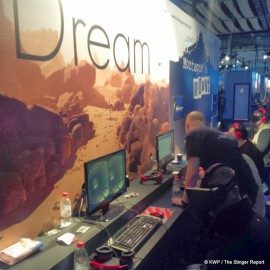VR Jam Winner Lau Korsgaard Talks ‘Virtual Internet Hacker’
VR Jam winner Lau Korsgaard talks to Road to VR about KnapNok Games‘ Virtual Internet Hacker, a VR fueled homage to the 90s hacker movie.
VR Jam winner Lau Korsgaard talks to Road to VR about KnapNok Games‘ Virtual Internet Hacker, a VR fueled homage to the 90s hacker movie.
Sixense’s successful STEM Kickstarter has been running for a few weeks now, but for the first time they’re showing the true power of their VR tracking system with full 5 point tracking. The results are, quite frankly, awesome.
Kevin Williams reports from EuroGamer Expo 2013 with Oculus Rifts abound!
Editor’s Note: Less than 7 months ago, I went to GDC 2013 to meet with a small contingent of VR believers — among them, Oculus VR Inc, Sixense, and Fourth Dimension Displays. Last week was the massive EuroGamer Expo 2013. Kevin Williams brings us a report from the show floor and shows the incredibly rapid grassroots spread of VR development, evident by widespread usage and interest in the Oculus Rift developer kit at EuroGamer Expo 2013.
—–
What proved to be London’s largest gathering of Virtual Reality (VR) entertainment technology, EuroGamer Expo 2013 also proved to be a vast mecca to the consumer game environment, but also became a clarion call towards the level of interest that has been generated in VR by the public.
This year’s EuroGamer Expo 2013 (EGX) proved a sold-out event over its three days, offering a mixture of elements found at Game Developers Conference, E3, and IndieCade, all in one location – housed in London’s famous Earls Court exhibition facility. Regarding the VR scene, the venue proved a melting pot of the latest hardware. Vying alongside the first UK public showing of the Microsoft Xbox One and Sony Playstation 4, VR was able to hold its own and give the consoles a run for their money.
Oculus VR
The Californian company made the long trek to the UK event and brought more than eight of their latest Oculus Rift HD prototype head-sets. This was the third time that the European scene had the chance to see the higher resolution and performance HMD – a prototype of one of the panel sections by the company. Representatives of Oculus VR were admittedly stretched thin to have to support so many shows, but felt it important to work with the consumer games scene to promote the best message regarding the public interest for the platform.
This was my first time in the HD version of the system, and I was impressed by the quality of image and the elimination of the ‘screen door effect’, but to hear that this was an intermediate step towards next years’ consumer HMD release increased faith in the start-ups drive towards a successful consumer launch. The queue to experience the HD version of the system snaked round the company’s booth for the duration of the Expo – a testament to the interest and fervor that has been generated by the company and their hardware.
Virgin Media
 The Virgin Media booth at EuroGamer Expo 2013 was a mix of indie games and new releases, built off of the launch of their Virgin Media Game Space (pop-up arcade) facility covered previously on Road to VR. Virgin Media as a main sponsor of EuroGamer Expo 2013 and had a prominent space; they made the most of it, including an Oculus Rift demonstration on their booth (entitled “Get Your Head in the Game”). The company had two systems running the skydiving experience seen at their pop-up space – and saw long queues at their booth to try out the experience.
The Virgin Media booth at EuroGamer Expo 2013 was a mix of indie games and new releases, built off of the launch of their Virgin Media Game Space (pop-up arcade) facility covered previously on Road to VR. Virgin Media as a main sponsor of EuroGamer Expo 2013 and had a prominent space; they made the most of it, including an Oculus Rift demonstration on their booth (entitled “Get Your Head in the Game”). The company had two systems running the skydiving experience seen at their pop-up space – and saw long queues at their booth to try out the experience.
Virtuix
 The virtual mobility system developers came to EuroGamer Expo 2013 with an example of the Virtuix Omni for selected visitors to try out. It was amazing to see the interest from those walking the vast Earls Court floor homing in to see the latest VR technology. The system presented under the tag line “Step Into The Adventure”.
The virtual mobility system developers came to EuroGamer Expo 2013 with an example of the Virtuix Omni for selected visitors to try out. It was amazing to see the interest from those walking the vast Earls Court floor homing in to see the latest VR technology. The system presented under the tag line “Step Into The Adventure”.
RePlay
The organizers of the popular Northern RePlay retro gaming event presented a great booth that looked back at the history of video gaming, and in a nod to the future the company had a independent developer running a Oculus Rift rig with an indie demonstration of his own design – great to see the independent development community working the Rift.
Design Media Kensington
One of the many universities that have courses in video game development – the Kensington course came to EuroGamer Expo with news of their development and showed some examples of their course work – this included a Oculus Rift running another independent demonstrations.
NFTS Games
In the game courses and employment area of the Expo another two Oculus Rift’s were spotted running some example demonstrations.
Bossa Studios
The popular Surgeon Simulator 2013 was presented on the EuroGame Expo 2013 show floor, and along with the normal PC version, the studio brought a Oculus Rift version of the amateur surgery game emulator – though the tracking was a bit off when visiting the booth, there was the customary long lines to have their turn on the game.
Independents
 In the Indie game area, the games Dream and Montague’s Mount (recently Steam ‘Greenlit’) were both demonstrated with Oculus Rift examples – seeming to illustrate a pattern where the credibility of some of the new PC content from independent developers is being seen as Rift suitable!
In the Indie game area, the games Dream and Montague’s Mount (recently Steam ‘Greenlit’) were both demonstrated with Oculus Rift examples – seeming to illustrate a pattern where the credibility of some of the new PC content from independent developers is being seen as Rift suitable!
Finally, the event proved a crowded and exuberant gathering of the latest games, consoles and aspirations in the consumer game medium – the VR contingent proving that this latest application of immersive entertainment has captured the imagination. We now have to wait what the next phase of interest will be once the first foray of these platforms are officially released.
For more information about EuroGamer Expo 2013 visit:
http://www.eurogamerexpo.com/whats-on/overview
About the Author – Kevin Williams has an extensive background in in the development and sales of the latest amusement and attraction applications. The UK born specialist in the pay-to-play scene; is well-known through his consultancy, KWP and as a prolific writer and commentator (The Stinger Report) on the emergence of the new entertainment market. Kevin is also the founder of the association and Conference (DNA Association/DNA Conference) that focuses on the digital Out-of Home interactive entertainment sector. Kevin can be reached at – kwp@thestingerreport.com – http://www.thestingerreport.com (both free to subscribe services).
Today begins the crowd-funding campaign for Powergrid, a virtual reality club and gallery created by developer Astrogun and intended for Oculus Rift users.
VorpX, the highly anticipated utility that adds Oculus Rift support to many existing games, is finally available to the public. The program makes it easy to enjoy your existing game library in virtual reality.
Total Cinema 360 is a company that specializes in recording 360 degree video. They’re now formatting their footage for the Oculus Rift head mounted display and enabling head tracking to let users look around the live action scene.
Kevin Williams once again brings us a report of the latest VR happenings in London. The second Oculus Rift /VR meetup hosted by Inition drew as many as 60 interested individuals and showed off a number of exciting VR demos.
Sixense has put together a video showing their STEM prototype played with one of my favorite Oculus Rift demos — Crashland. The Sixense team is also doing an AMA (Ask Me Anything) session on Reddit where the community can post questions directly to the creators of the Hydra and STEM.
The already highly successful STEM Kickstarter just keeps getting better. A new update from the team at Sixense brings prices down, adds a new stretch goal at $700,000 for iOS/Android, and introduces a new $149 reward level.
It looks like we’ve got a new challenger to Project Holodeck. ‘Inversion Project’ by Zero Latency Media is a low-cost, portable VR environment that allows players to crouch, jump, and move around a physical space while having that movement mirrored in a virtual reality game. The developers are showing off an early demo using the environment with a game called Zombie Fort: Smackdown.
A certain web based seller is advertising to sell prospective buyers Oculus Rift Development Kits in bulk. Something’s amiss here, Road to VR investigates.
Fancy re-living one of the most iconic scenes in Cinema history? Author Boone (of Rift Coaster fame) has released video of new Star Wars inspired demo for the Oculus Rift.
We talk to E McNeill (real name Ed, known as ‘E’), author of Ciess – recently crowned winner of the Indiecade VR Jam contest. We discuss what the development process was like and of course whether Ciess will see a full commercial release.
Hello dear readers, and welcome to the latest version of our site. For those of you wondering why we’ve been slow on the reporting lately — now you know!